#muehzala

Preface
- Interested in the potential benefits that might come from plumbing the depths of the Maw, Cartel Ve planned an exploratory venture into the dark realm. The expedition, overseen by Ve’nari, was a success. However, Ve’nari had her fellow cartel members killed to ensure she alone would have sole access to both the Maw Walkers and the Maw’s resources (8, 132).
- Cartel Ve and Cartel Ta are rivals (8, 29).
- It is loosely implied that the Brokers altered their demeanor, if not also their appearances, to look friendly and appealing to mortals. They refer to their outward form as their “encounter suits” (9).
Chapter One: Rites of the Dead on Azeroth
- After a night elf has died, they are ritually cleansed in pools of moonlit water. Kaldorei priestesses deftly weave arcane and nature magic together to mend the dead body in preparation for a final viewing. Throughout this process, the priestesses sing songs in their temples honoring the deceased’s achievements and sacrifices in life. The deceased is then covered in a burial shroud, placed on a bier, and brought to a grove of trees where a druid magically ensconces the corpse in various plants so it can be returned to nature (13).
- Some night elves form a strong enough bond to nature that even after their death, they remain tethered to the mortal realm as a wisp [Quest: Wisp in the Willows]. This phenomenon may, however, be in part due to the intervention of the elven moon goddess, Elune (13).
- At some point in the past, Trade Prince Donais died and passed on to Revendreth (14).
- During goblin funerals, it is customary to read off a list of all the assets the deceased held in life (14).
- The Kul Tirans choose not to bury their people, believing instead that the fallen should be given to the sea [Quest: Lost, Not Forgotten, Item: Soggy Treasure Map]. An artifact called the “Dead Ringer” is a crucial part of these Kul Tiran funerary rites. In ringing the bell, it is believed the deceased’s soul is able to rise above the depths as their body sinks beneath the waves (17).
- Mourners traditionally release star moss – a magical flower notable for its sensitivity to feelings of loss – into the ocean during Kul Tiran funerals [Quest: Here In Spirit], (17).
- Cairne’s wife lingered in the mortal world as a spirit after her passing to keep watch over her bondmate and son. It is unclear why she was not brought to the Shadowlands by the Kyrian. That said, it is known that Kyrian cannot take the souls of those who are tethered by a sufficiently powerful force to their plane of origin (18).
- Tauren, not unlike orcs, construct large funeral pyres to cremate their fallen on. The ashes of their fallen are scattered to the winds, at which point it is believed they rejoin the Earth Mother (18).
- Tauren heroes are buried at Red Rocks in Mulgore. According to the tauren, the sacred nature of Red Rocks and other burial sites enables the spirits of the dead to briefly cross the Veil and talk to the living – something which the Brokers are highly skeptical actually occurs, given the design of the Shadowlands (18).
Chapter Two: Entering the Shadowlands
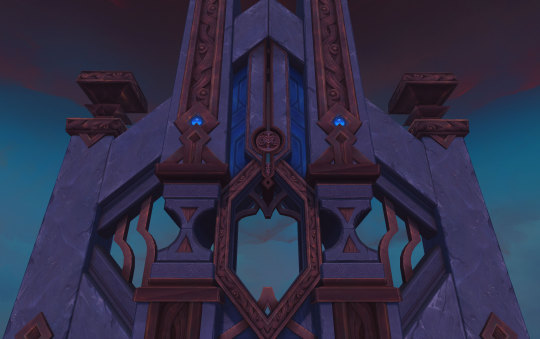
- A mortal soul accumulates anima through its deeds and experiences in life. As a result, anima varies from soul to soul (24, 30).
- The Brokers have been unable to catalogue every single afterlife in the Shadowlands, for there are too many to count (27).
- The origins of the Maw are unknown to even the Brokers. According to a member of Cartel Ta, it seems the Maw’s origins have all but been “purged from the annals of history” (29).
- The elemental forces of spirit and decay may or may not have an influence on how much anima a soul produces in their lifetime (31).
Chapter Three: Oribos
- Various Broker cartels financed expeditions to find and stake proprietary claim on Oribos. It was eventually discovered – perhaps accidentally – by an Au cartel navigator (35).
- The coiled serpent, thought to embody the infinite cycle, is a well-known symbol of the First Ones (36).
- The Brokers believe that Oribos was built explicitly for the judgement of souls well before the first mortal soul ever arrived in the Eternal City (38).
- On the other hand, the Arbiter’s attendants claim that the Arbiter chose to judge souls in Oribos of her own volition, which contradicts the Brokers’ theory (38).
- Old, worn records seem to suggest that there was a time when the Arbiter was not as benevolent as she is made out to be today (38). Of course, that is because the Jailer formerly held the role of Arbiter before he was imprisoned in the Maw [NPC: The Primus Dialogue].
- The attendants of Oribos are broken up into three groups: the Hands of the Arbiter, the scholars, and the protectors (41-42).
- The Hands of the Arbiter, the largest group of attendants, are responsible for maintaining the functions and stability of Oribos (41).
- The protectors make up the smallest selection of attendants. The highest position a protector can ascend to is the Shield of the Arbiter (42).
- Legend has it that at least one Fatescribe can affect the destinies of living mortals (42).
- The Brokers are aware there is a rumor that claims they were once another race of beings who shunned their original name and form (43).
- Within Oribos, the Au Cartel is responsible for supplying resources to mortals seeking to build up their own trade skills. Cartel Ta, on the other hand, is popular for selling unusual and uncommon items of value (44).
Chapter Four: Ardenweald
- Ardenweald’s celestial trees act as the primary means of anima distribution across the realm (50).
- Druids, hunters, and shaman all have such a deep connection to nature that they are usually sent to Ardenweald upon their death (50).
- One’s soulshape form mirrors the true nature of their bond with the wilds (51).
- Though most Wild Gods take on the form of animals in Ardenweald, it is notable that Cenarius retains a largely humanoid appearance. While it is unclear exactly why, it was hinted at that he receives preferential treatment from the ruler of Ardenweald – perhaps because he is her nephew (53).
- To save Ysera, the Winter Queen permanently sacrificed a portion of her own essence (54).
- Elune, the Winter Queen’s sister, is presumed to be a part of a “Pantheon of Life” (56).
- A full assembly of the Wild Hunt is rare, perhaps because the Hunt’s troops are usually needed as caretakers, stewards, and protectors in each of Ardenweald’s individual groves (58).
- Though the Winter Queen is technically the ruler of Ardenweald, governance of the night fae falls to a council known as the Court of Night. Their members include the late Droman Krelnor, Lord Renard, Lady Moonberry, Droman Aliothe, and Droman Tashmur (59).
- The tree-like appearance of the tirnenn is likely because they were the first fae to emerge in Ardenweald. They can alter the forests at will (59).
- Tirna Achiad, the Heart of the Forest, is supposedly the very first tree the Winter Queen cultivated in her realm (60).
- Sylvar typically function as Ardenweald’s crafters and tenders. The Vorkai, on the other hand, stand as the protectors of the realm (60).
- It is said that the faeries of the Night Fae are nearly as skilled as the Brokers in the art of illusion (60).
Chapter Five: Bastion
- The Light-Bearers of Fanlin’Deskor – a planet long since destroyed by the Burning Legion – were typically sent to Bastion by the Arbiter [Short Story: Velen: Prophet’s Lesson], (69).
- Kyrian “Watchers” primarily operate in the mortal realm. True to their name, Watchers observe souls to determine if it is their time to move on to the Shadowlands or if there is some force still tethering them to the mortal plane (77).
- Once a Watcher has dictated it is a mortal’s time to move on, a Kyrian Bearer is responsible for carrying the deceased’s soul to Oribos (77).
- The Forsworn inadvertently turn a darker, purple-ish hue that reflects the personal turmoil they feel within themselves (80).
- While the Forsworn have only recently appeared in great number in Bastion, they are not a new phenomenon. Some aspirants in the past did fail to ascend and became Forsworn, though they were something of a rarity. Even more uncommonly, aspirants ultimately unable to find their way back to the path would be exiled from Bastion and re-judged by the Arbiter so they could be sent to another afterlife (80).
- Stewards keep mementos of their small achievements just in case they happen to forget any of their accomplishments (81).
- The device Kyrian use to soul bond bears a striking resemblance to First Ones artifacts (86).
Chapter Six: Revendreth
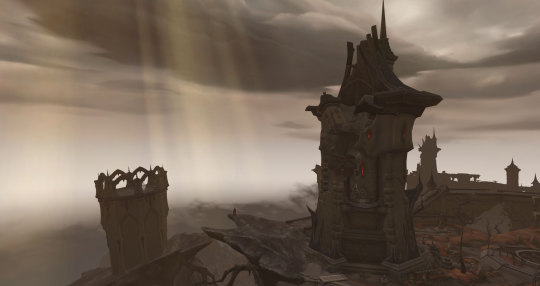
- When the drought started, Sire Denathrius used the spires of Revendreth to siphon ambient anima and add it to his hidden stores within Castle Nathria. It said that he was the “architect” of the drought (95).
- Sinfall tower is where Denathrius first founded the Court of Harvesters (102).
- Surprisingly, the walls of Sinfall withstood the Light’s bombardment in the Ember Ward. Rumor has it that this is because the defenses Denathrius implemented to contain the powers within Sinfall were so strong they kept even the Light at bay (102).
- The Venthyr’s unique ability to wend through the shadows is considered translocation magic (105).
Chapter Seven: Maldraxxus
- The Primus has the power to alter the landscape of Maldraxxus. Supposedly, he shaped the realm so it would serve as an ideal training ground for the ultimate army (112).
- Each of the five houses embodies one of the five traits of the ideal champion of Death (114).
- According to legend, the only losses the Primus ever suffered were intentional (116).
- The Primus, an expert in runes and runic power, created the language of Domination expressly to bind the Jailer within the Maw (116, 120).
- Each symbol in the Primus’ runic language represents a specific word tied to the foundations of Maldraxxus and its five houses. These could consist of anything from simple commands to necromantic energy manipulation and be used to imbue weapons with dark power or as a focus of binding magic, among other things (118).
- Death Knights emblazon their weapons with these runes of domination, though it is unclear how they ever came to learn Runeforging when it originated in the Shadowlands (118).
- The Jailer’s true name is said to hold dark power, which is why he is often referred to as the “Banished One” or “the Jailer” in official records (120).
- It is theorized that the Jailer learned to harness the Primus’ power of Domination for himself and ultimately used it to break his prison (121).
- Information exchanged in soulbinding does not completely fade, even if one of the bondmates should perish (126).
Chapter Eight: The Maw

- Many afterlives dedicated to the temporary punishment of souls exist, not just Revendreth (132).
- Before the Arbiter was broken, very few souls were ever sent directly to the Maw. If they indicated that they had even the slightest chance of atoning for their sins, they were sent to Revendreth (132).
- Cartel Ta’s archives contain no accounts of the Jailer’s appearance or his purpose beyond overseeing the souls in the Maw (135).
- It is pointed out how odd it is that a Waystone – a form of translocation – was placed in a realm explicitly meant to be inescapable. The Brokers consider two theories: the first asserts that the Waystone was intended as a failsafe in case any souls should arrive in the Maw that were not meant to be there. The second, on the other hand, claims the First Ones foresaw the coming of the Maw Walkers and placed the Waystone there for their inevitable arrival (141).
- Despite the numerous deaths he endured, Kel’Thuzad was never actually judged by the Arbiter until his final death during the war against the Lich King (142).
- One Broker believes the Arbiter’s judgement of Kel’Thuzad may have been manipulated to ensure he ended up in Maldraxxus, where he could further the Jailer’s schemes (142).
- As the troll death deity, Mueh’zala once demanded his followers perform brutal displays of worship. His needs were so extreme that he continued to thrive upon their fear and despair after they died, preventing them from passing on to the rest of the Shadowlands (144).
- However, troll civilization eventually outgrew Mueh’zala’s interest in cruelty and death. Determined not to fade into obscurity, the loa of death extended an offer to one of his priests, a troll named Bwonsamdi: in exchange for becoming Mueh’zala’s successor, Bwonsamdi was to deliver a regular tribute to the loa, thereby ensuring Mueh’zala would always have the worship he craved (145).
- When the Arbiter broke, Bwonsamdi tethered the souls of dead trolls to his Necropolis to prevent them from passing on to the Maw and empowering the Jailer. Mueh’zala, who had been in league with the Jailer for some time, was enraged at this and attacked Bwonsamdi in the Other Side (145).
- Mueh’zala brokered the deal with Odyn in which the titan-forged Keeper gave his eye to peer into the Shadowlands (145).
Chapter Nine: The First Ones and the Grand Design
- The Brokers set out from their realm of origin upon great barge cities to discover the truths of the First Ones (149).
- Other heretofore unknown First Ones realms include places like Baraneth and Nirem-Ahn. While the mortals know little about these realms, it seems the Brokers have already been to them (149, 151).
- Cartel Al outbid Cartel Ta on leading the expedition to seek out the Sepulcher of the First Ones (151).
- The First Ones were the progenitors of all realities and Pantheons (151).
- The language of the Titans uses the same word for “created” and “Ordered” (154).
- “Zereth” – first heard in the name of the First Ones realm, Zereth Mortis – translates to either “keystone” or “cornerstone” [NPC: Tal-Galan Dialogue], (160).
Epilogue
- Ta’lora, a Broker of Cartel Ta, has put forth the suggestion that their cartel should expand their market to the mortal plane to overcome the achievements of their rivals in Cartel Ve (163).
One of the biggest and most valid criticisms of Shadowlands is that is doesn’t present an inclusive Afterlife for Tauren and Trolls, who have had such a deep connection to the Shadowlands since their inception as WoW races.
Not only that, but in hindsight there was a lot about Battle for Azeroth that was misunderstood. I misunderstood a lot of the story because I wasn’t looking for hints of the Jailer in Battle for Azeroth. When I went looking for the real plot, I stumbled on a plot thread that feels like it should have been bigger and more tangible but it wasn’t. The plot was the partnership between Zul the Prophet, Azshara, Sylvanas and N’Zoth. It was Zul not Talanji that Sylvanas wanted to secure from the Stockades, Talanji just happened to be there and the misconception was we were there to free her to bring the Zandalari into the Horde. It was Zul who set up Sylvanas recovering Xal’atath and setting up a meeting between Sylvanas and Azshara. He was the asset to be recovered.
It’s unclear how Zul and Talanji came to be in the same prison, Talanji says that they were seeking out the Horde to help them with external threats, but Zul has a tumultuous history with Zandalar and he was actually banished from Zandalar in Cataclysm because of his prophecies, and persistent visions of Deathwing, annoyed Rastakhan. He was banished and he spent a lot of time between Cataclysm and Battle for Azeroth with the Sandfury trolls. Presumably getting closer to their patron Loa Mueh’zala. I’m sure by now you can see where I’m going with this.

It’s becoming more and more clear to me that Zul had some kind of pre-existing knowledge of the Jailer and Mueh’zala’s plan to whisper to Vol’jin to make Sylvanas Warchief. Now, it’s important to note here, that it’s not clear if Sylvanas actually knew that the Jailer was going to make her Warchief or if that was part of her plans or if the Jailer was doing this to manipulate her. In the novel Before the Storm, Sylvanas’s internal monologue suggests that she did not know about the whisper to make her Warchief because she curses Vol’jin and his Loa.
Zul has a bit of dialogue in the Welcome to Zandalar cinematic that seemed strange when it was live, but in hindsight it takes on a whole new meaning if the Jailer was in fact manipulating Sylvanas and she was not in fact in control, and Zul knew this

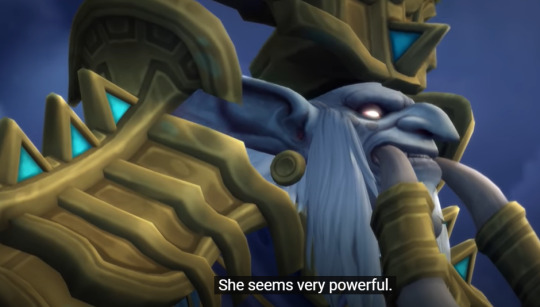
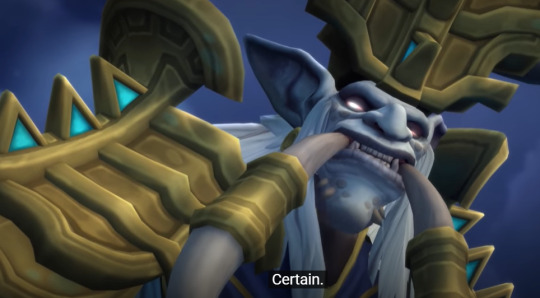

I have to admit the other times I watched this cinematic I thought this interaction between Zul and Nathanos was Zul taking a low shot at Nathanos for his loyalty. But now in hindsight it seems more like Zul was letting on that he knew more about the Jailer and Mueh’zala’s interference and he was almost mocking Sylvanas in a way, that she really has no control over fate, the Jailer has that much control over her but also the the events of this world. I have a few other lore posts on how Battle for Azeroth ties into the Shadowlands especially in regards to Mueh’zala and Hakkar, but the main one is De Other Side- A Good Place to Start
The Dungeon Journal text for Mueh’zala suggest that he made an ancient deal with the Jailer. It’s hard to rationalize that the Jailer has alwaysbeen a major threat to Azeroth because he was so mysterious that there was no way to form any connections between his goals and what was happening on Azeroth. In hindsight the Jailer has been responsible for every threat, from the Legion, to the Lich King, to even the rise of the Zul Empire, he’s been there, he’s been pushing his ultimate goal and it seems like he finally found the right person to achieve his goals, someone he has cleverly manipulated in the same way he manipulated jin’do the Godbreaker.
The plans he laid in ancient times to reclaim that power are coming to fruition, once he deals with his rebellious replacement.

Asking the question, could the seeds of the Jailer have been planted since vanilla World of Warcraft ? yes answer is astonishingly yes. When you look at the history of Jin’do, how he was broken in the Maw, how he was twisted the the will of the Jailer, you see that same pattern emerging again in the story story Edge of Night, with Sylvanas. With each soul devoured he got close to ripping a hole through this world.
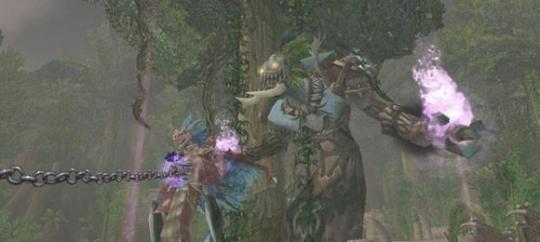
Jin’do seems to have been such a integral piece of the puzzle, in regards to the Jailer, and yet he’s nowhere to be found in the Shadowlands. Not even a mention. Hakkar is easily dealt with in De Other Side and this whole story revolving around Mueh’zala is just a footnote in the Shadowlands, and seems like it’s dealt with rather quickly in the covenant quest chain of Ardenweald.
I can only hope that 9.1 and other Shadowlands content on the way to 10.0 we get a chance to really delve deeper into this side of the lore. Exploring not only Zul’s character and his relationship with the Jailer and Muah’zala, but also uncovering more about the connection between the Jailer and N’Zoth.
The Power of Prophecy
Prophecy can be a great foreshadowing plot device. It’s one of those things that when done properly it can turn into some really big payoffs, when done poorly it can flop. The worst thing any writer could do is to write in a prophesy and then fail to deliver. I have to admit some of the dialogue I’m encountering in Battle for Azeroth when framed against an emerging shadowlands plot about a War on Fate. Makes random dialogue like this hit just a bit different.

“Shadows twist the strings of fate, In the end the great king will be made to kneel.”
Even though this prophesy could be about Rastakhan and the fall of the Zandalari empire, Rastakhan never was made to kneel.. but what if… indulge me here on a little conspiracy theory…
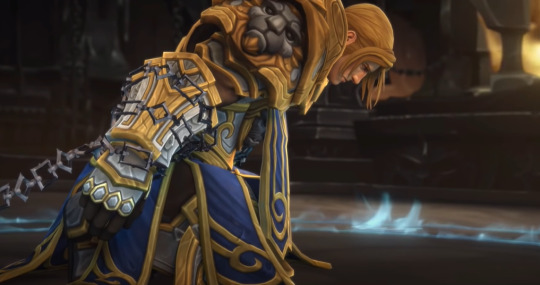
Now, look at what Christie Golden wrote in the synopsis of her new book.
“The power to achieve her goals has never been closer, as Sylvanas works alongside the Jailer to liberate all Azeroth from the prison of fate. Her final task? Secure the fealty of their prisoner—King Anduin Wrynn. “
Sylvanas wants to liberate all Azeroth from the prison of fate.
I’m not going to try and convince anyone that the writing team is full of exceptional writers, but I put a lot of stock in the fact that they are very consistent and predictable writers. And this is is how I form my speculation and I’m generally not disappointed in the story. At the very least they are following through with plots they set up.
